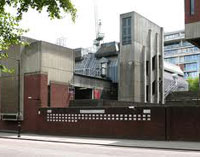
No sale of one of London’s prime residential development opportunities will be likely before 2020, according to the Ministry of Defence.
A sale of the Hyde Park Barracks, SW1, was first proposed in 2012, but there have since been years of delays owing to the need to find a new home for the House Cavalry Mounted Regiment based there.
Lynne Reah, deputy head of commercial at the Defence Infrastructure Organisation, said that it was hoped procurement would start in spring 2018, while the invitation to submit outline proposals would take 12 to 18 months. As a result, no scheme could be approved until 2020.
The six-acre site is one of the MoD’s most valuable assets, and could be converted into a residential development worth up to £2bn. Some estimates put the land value at £500 to £600m. The MoD has spent the past six months re-appraising options for the site, after appointing GVA in September last year.
The future of the site was discussed in an MoD webinar.
An enquiry by design event was held in October last year that came up with 11 possible solutions for the site. These revolved around four main options, which are complicated by troops that are stationed in London across its six sites, listed below:
• Hyde Park Barracks, Knightsbridge, SW7: Household Cavalry Mounted Regiment
• Wellington Barracks, St. James’s Park, SW1: Foot Guards
• Woolwich Barracks, SE18, Kings Troop Royal Horse Artillery (for sale)
• Regent Park Barracks, Camden, NW1 transport and logistics
• Windsor Barracks, SL4
• Hounslow Barracks, TW3 (for sale)
The overriding challenge, according to the MoD, is to provide better accommodation to maintain health and welfare of people, while maintaining military capability.
All four options were identified after applying the following three criteria: operational viability, issues with delivery, and any benefits that may be gained.
The four options:
• No change: the MoD would continue to use all existing sites. However, it would be difficult to maintain these and find the funding to do it. The King’s Troop Horse would still move to Regents Park.
• Consolidation of the Hyde Park site: current barracks would be rebuilt on the western half of the current site, with the eastern half to be sold for development. This would lead to logistical issues during the transition. The King’s Troop would go to Regent’s Park while the Household Cavalry Band would move to the Wellington Barracks.
• Total move from Hyde Park site: the HCMR would move into the nearby Wellington Barracks, freeing up the entire Hyde Park site for redevelopment. New accommodation at Wellington Barracks could be built with or without improvements for the Foot Guards. There are issues with the complexities of transition and access to Hyde Park. However, this option allows the complete redevelopment of HPB, and is fully self-funded.
• Relocation to non-MoD site: the MoD has not yet been able to identify any sites that fall into this category, nor are suitable. A spokesman said: “However, this was some time ago, and yourselves in industry may come forward with alternatives.” The Nurseries site had been identified in Hyde Park, but the Royal Parks Commission has reaffirmed there will be no development in Hyde Park.
Barney Hildon of GVA said there were two possible deal structures: either a single contract with a partner or consortium to develop out and re-provide for the horses, or doing each – development and re-provision – through a separate contract.
He also said the site, which includes a Sir Basil Spence-designed tower, was immune from listing until 2021.
Hyde Park Barracks: a short history
• The site has been the base for the Household Cavalry Mounted Regiment, which also mounts the Queen’s Life Guard at Horse Guards, since the first buildings were constructed for the Horse Guards in 1795.
• The Sir Basil Spence-designed modernist scheme was completed in 1970.
• In June 2012, CBRE was appointed for initial advice on what the Defence Infrastructure Organisation calls a “market-testing exercise” to decide the future of the site.
• In January 2014, speculation abounded about the site being sold.
• Paul Howarth, the civil servant in charge of the project, left the DIO in January 2014, slowing the sales process.
• The MoD drafted plans in May 2015 for a potential sale of the site through the DIO, though there was no official announcement.
• Lipton Rogers Developments, SD&B International and CPC Group, and the Qatar Investment Authority have all previously looked at the site.
• The estimated value of the site is £500m-£650m, with some schemes rumoured to have potential end values of £2bn.
• GVA was appointed in September 2016 to explore options for the site.
An MOD spokesperson said: “We’re looking for views on how to ensure that the Defence Estate in London meets the needs of our Armed Forces while delivering best value for money for the taxpayer, and this webinar is part of that process.
“This work is at an early stage and no decision has been taken to dispose of any site other than those announced in November.”
• To send feedback, e-mail alex.peace@estatesgazette.com or tweet @egalexpeace or @estatesgazette










